|
|
|
| My Favourite Planet > English > Europe > Greece > Northern Aegean > Samos > gallery |
| Samos, Greece |
Samos gallery |
 |
 |
13 of 55 |
 |
 |
|
| |
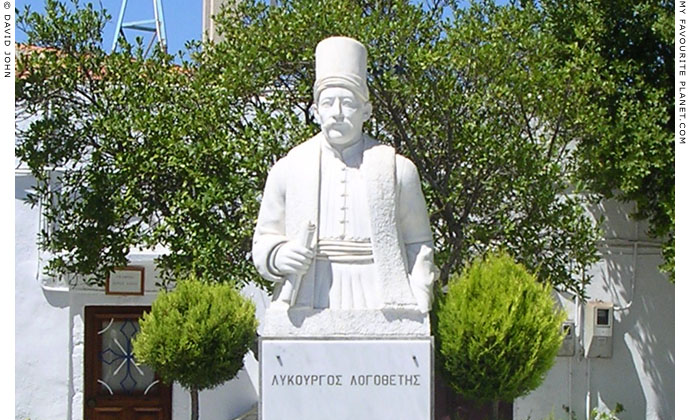
Statue of Lykourgos Logothetis in front of the Church of the Transfiguration, in the Castle of Logothetis. |
| |
For information about the Castle of Logothetis,
including opening times, see the previous page.
Church of the Transfiguration,
Pythagorio
(ο Ιερός Ναός της Μεταμορφώσεως του Σωτήρος, the Holy Church of the Metamorphosis of the Saviour)
The church was built 1831-1833, at the end of Greek War of Independence, by Lykourgos Logothetis (see below) in the grounds of the Castle of Logothetis.
The church was dedicated to the Transfiguration of Christ [1] to commemorate the Greek victory at the naval Battle of Samos against the Turkish fleet, which took place in the Samos Strait on 5th August 1824. By 6th August, the day on which the Transfiguration is celebrated by the Greek Orthodox Church, the Samians were safe - for the time being.
On the plinth of the bust of Lykourgos Logothetis in the churchyard is the following inscription in Greek:
"Λυκούργος Λογοθέτης
Χριστος Σαμον εσωσεν
εkτη Αυγουστου 1824
Δωρητής Εμμανουήλ Στέφ[ανος] Μωραΐτης"
"Lykourgos Logothetis
Christ saved Samos 6th August 1824
Donated by Emmanouil Stefanos Moraitis"
The word "saved" is not an overstatement, as the inhabitants of nearby Chios and Psara which, like Samos, declared independence from the Ottoman Empire in 1821, had recently been massacred after the islands were captured by Turkish forces.
Logothetis vowed to build the church as an act of gratitude for the victory, but due to the continuing war and consequent economic problems, building did not begin until 27 February 1831.
Logothetis planned the building himself and made a wax model of the design. The construction was supervised by Georgios Petros from the Cretan village of Marathos, and completed on 15 June 1833.
Just before his death in Athens in 1850, Logothetis financed the renovation of the church. |
|
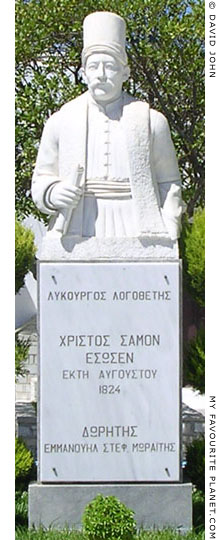
Lykourgos Logothetis |
|
| |
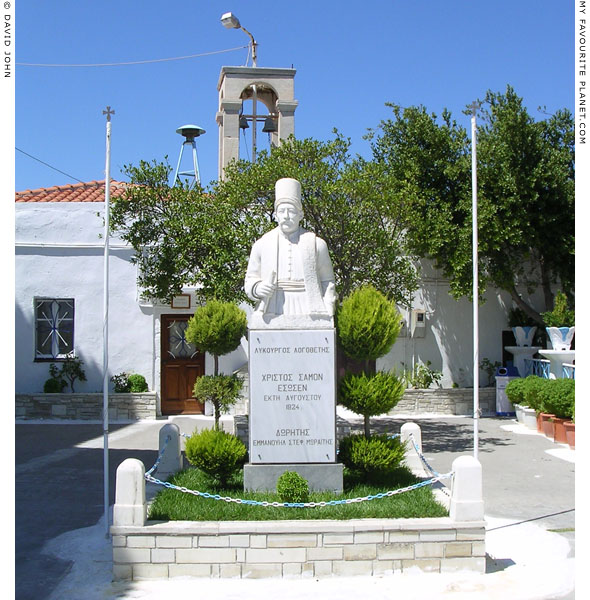
The statue of Lykourgos Logothetis in the chuchyard of the Church of the Transfiguration. |
| |
Lykourgos Logothetis
George Lykourgos Logothetis (Γεώργιος Λυκούργος Λογοθέτης, 1772-1850, often referred to as Lycurgus Logothetis) was a leader in the Greek War of Independence (Ελληνική Επανάσταση, Elliniki Epanastasi; also known as the Greek Revolution, 1821-1829).
Born George Paplomatas (Γεώργιος Παπλωματάς), the son of a shipowner in Karlovasi, on the north coast of Samos, he changed his name when he became a member of the Filiki Eteria (Φιλική Εταιρεία, Society of Friends), the secret society dedicated to establishing an independent Greek state.
He studied in Constantinople (today Istanbul), then worked as an official in the administration of Konstantinos Ypsilantis (Κωνσταντίνος Υψηλάντης, 1760–1816), the ruler of Wallachia (now part of Romania) 1802-1806.
He became ruler of Samos from 1807 until 1812 when he was ousted due to political rivalries on the island. In exile he became a member of the Filiki Eteria, which was led from April 1820 by Alexandros Ypsilantis (Αλέξανδρος Υψηλάντης, 1792-1828) the son of his former employer.
He returned to Samos in April 1821, at the outbreak of the Greek War of Independence, and was made the political and military leader of the rebel island which claimed independence from Ottoman Turkey and established a revolutionary government with its own constitution. In the summer of the same year the Samians thwarted a Turkish attempt to capture the island.
In 1824 Koca Hüsrev Mehmed Pasha (1769–1855), Kapudan Pasha (Kapudan Paşa or Kaptan-ı derya, grand admiral) of the Turkish navy, captured the nearby island of Psara and massacred its inhabitants. His fleet then attacked Samos.
The Greek fleet, commanded by George Sachtouris (Γεώργιος Σαχτούρης, 1783-1841), forced the Turkish fleet to withdraw at the Battle of Samos (η Ναυμαχία της Σάμου) on 5th August 1824 (Julian calendar; 17th August in the modern Gregorian calendar [2]). The Greek success was largely due to the use of fireships set off by Constantine Kanaris (Κωνσταντίνος Κανάρης, circa 1795 – 1877 [3], later admiral and prime minister of Greece) which destroyed three Turkish ships.
The battle was inevitably compared to another famous Greek military victory off the coast of Samos, the Battle of Mykale (η Μάχη της Μυκάλης) on 27th August 479 BC, when the allied Greek city states, including Athens, Sparta and Corinth, defeated the fleet of Persian King Xerxes I on the coast of the Mykale peninsula.
Later in the same month, on August 29th 1824 (Julian calendar), the success of the Greek fleet at the Battle of Gerontas (η Ναυμαχία του Γέροντα), off the island of Leros, consolidated Greek control of Samos, although the Turks made another attempt to take the island in summer 1826.
In 1828 the island was incorporated into the First Hellenic Republic (Αʹ Ελληνική Δημοκρατία, 1822–1832) under Governor Ioannis Kapodistrias. However, according to the treaties which ended the war, on terms laid out by Britain, Russia and France (particularly the Treaty of Constantinople, 1832, and the London Protocols of 1830 and 1832), Samos was to be returned to Turkish control as a nominally autonomous principality.
The Samians refused to accept this arrangement, and Logothetis declared Samos an independent state governed by its own constitution of 1821. Pressure from the Great Powers and the arrival of another Ottoman fleet in May 1834 forced the revolutionary leaders and many other Samians to flee to Halkida on Euboea.
Logothetis, who the Greek state gave the rank of colonel, went to live in Athens where he became a senator, and eventually died in May 1850.
Samos finally became part of the modern Greek state during the First Balkan War, when in October 1912 the Greek Navy landed troops on the island, including exiled Samians led by Themistoklis Sofoulis [4], and within three days forced the Ottoman troops there to withdraw to the Anatolian mainland. The island's parliament declared union with Greece in November 1912, and unification officially took place on 2nd March 1913. |
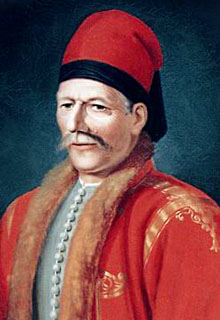
Portrait of Lykourgos Logothetis
by Dionysios Tsokos (1814-1862).
National Historical Museum of Greece |
| |
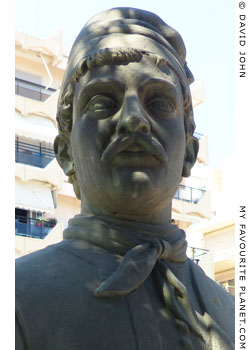
Modern bust of Constantine Kanaris
on the seafront of Alexandroupoli. |
| |
| |
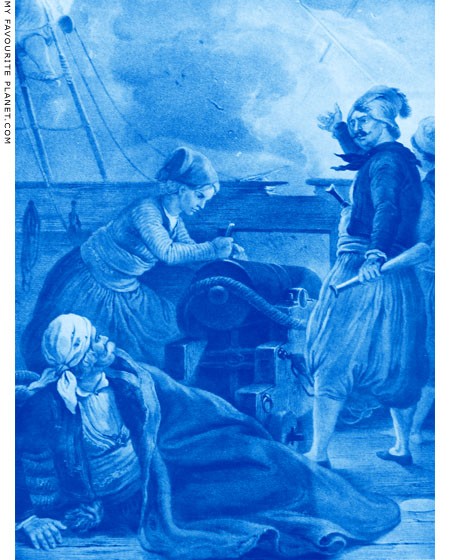
A lithograph of the painting "Victory of Satchuris at Samos" by Peter von Hess (1792-1871).
From the album Griechenlands Befreiung (Greece's liberation; English title The deliverance of Greece),
a folio of 36 prints of paintings by Hess illustrating scenes from the Greek War of Independence, titled
in German, Greek, French and English. Printed by J. B. Kuhn. Published H. Kohler, Munich, circa 1835.
Photo from an original print exhibited in the War Museum of Nafplion, Greece. |
| |
| Samos |
Notes, references and links |
 |
|
1. The Transfiguration of Christ
Also known as the Metamorphosis of the Saviour (Greek, Μεταμορφώσεως του Σωτήρος, Metamorfoseos tou Sotiros), celebrated on 6th August, is an important holy day in the calendar of the Greek Orthodox Church. The feast is also recognized by other Christian denominations, although some celebrate it on other dates.
According to accounts in the New Testament by Matthew (17:1-9), Mark (9:2-8) and Luke (9:28-36), Jesus took three of his disciples, Peter, James (son of Zebedee) and John (brother of James), to a mountain where he revealed himself as the Son and messenger of God in a miraculous and dramatic manner.
In the Gospel according to Matthew (17:2), Jesus "was transfigured before them; his face shining as the sun, and his garments became white as the light." The prophets Moses and Elijah (Elias) appear and Jesus speaks with them. Then a bright cloud appears, from which they hear a voice saying: "This is my beloved Son, with whom I am well pleased; listen to him." The disciples fall to the ground in fear, but Jesus tells them not to be afraid. When they look up the apparitions have vanished.
The accounts of these events in all three gospels are almost identical. It seems odd that John, the only gospel author who was actually present, does not mention the Transfiguration, although some scholars see an allusion to it in John 1:14: "And the Word became flesh and dwelt among us, (and we beheld his glory, the glory as of the only begotten of the Father), full of grace and truth."
Peter also alludes to the event in his Second Epistle General (2 Peter 1:16-18): "For we have not followed cunningly devised fables when we made known unto you the power and coming of our Lord Jesus Christ, but were eyewitnesses of his majesty. For he received from God the Father honour and glory, when there came such a voice to him from the excellent glory, This is my beloved son in whom I am well pleased. And this voice, which came from heaven, we heard when we were on the holy mount."
Although none of these accounts name the "high" and "holy" mountain on which the Transformation occured, many scholars have attempted to identify it.
2. The Julian and Gregorian calendars
The Julian calendar, introduced by Julius Caesar in 46 BC, was superceded by the Gregoran calendar (also called the Western calendar and the Christian calendar), introduced by Pope Gregory XIII in 1582. It was gradually adopted by most countries, but Greece used the Julian calendar until 1st March 1923 (Gregorian). The Greek Orthodox Church still uses the Julian calendar to calculate the date of holy days such as Easter.
3. Historical sources give various dates between 1793 and 1797 for Kanaris' birth.
4. Themistoklis Sofoulis (Θεμιστοκλής Σοφούλης, 1860-1949) was born in Vathy, attended high school in Pythagorio, and studied in Athens and Germany. Before his political career he was an archaeologist, excavated at Messene and lectured in Athens University. He became a prominent member of the Greek Liberal Party (Κόμμα Φιλελευθέρων) under Eleftherios Venizelos, and a member of the Samos parliament. He was President of Samos until 1914 when he was appointed Governor General of Macedonia. Later he served for a short period as Prime Minister of Greece. |
|
|
Photos, maps and articles: © David John 2003-2019,
except where otherwise specified.
All photos and articles are copyright protected.
Images and materials by other authors
have been attributed where applicable.
Please do not use these photos or articles without permission.
If you are interested in using any of the photos for your website,
publication or project, please get in contact.
Higher resolution versions are available on request.
Some of the information and photos in this guide to Samos
originally appeared in 2003-2004 on davidjohnberlin.de.
My Favourite Planet makes great efforts to provide
comprehensive and accurate information across this website.
However, we can take no responsibility for inaccuracies or changes
made by providers of services mentioned on these pages. |
| |
 |
Visit the My Favourite Planet Group on Facebook.
Join the group, write a message or comment,
post photos and videos, start a discussion... |
|
|
| |
|
|
| |
| |
 |
| |
 |
| |
 |
| |
 |
| |
 |
| |
 |
| |
George Alvanos
rooms in
Kavala's historic Panagia District
Anthemiou 35,
Kavala, Greece
kavalarooms.gr
|
| |
Olive Garden Restaurant
Kastellorizo,
Greece
+30 22460 49 109
kastellorizo.de
|
| |
Papoutsis
Travel Agency
Kastellorizo,
Greece
+30 22460 49 286
greeklodgings.gr
|
| |
|